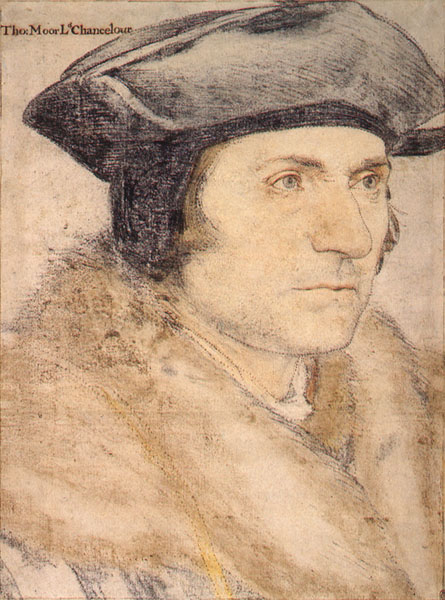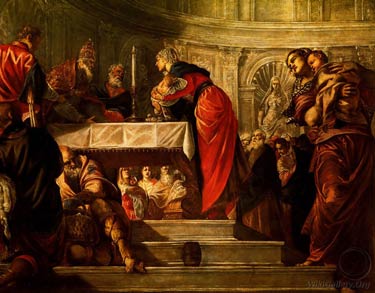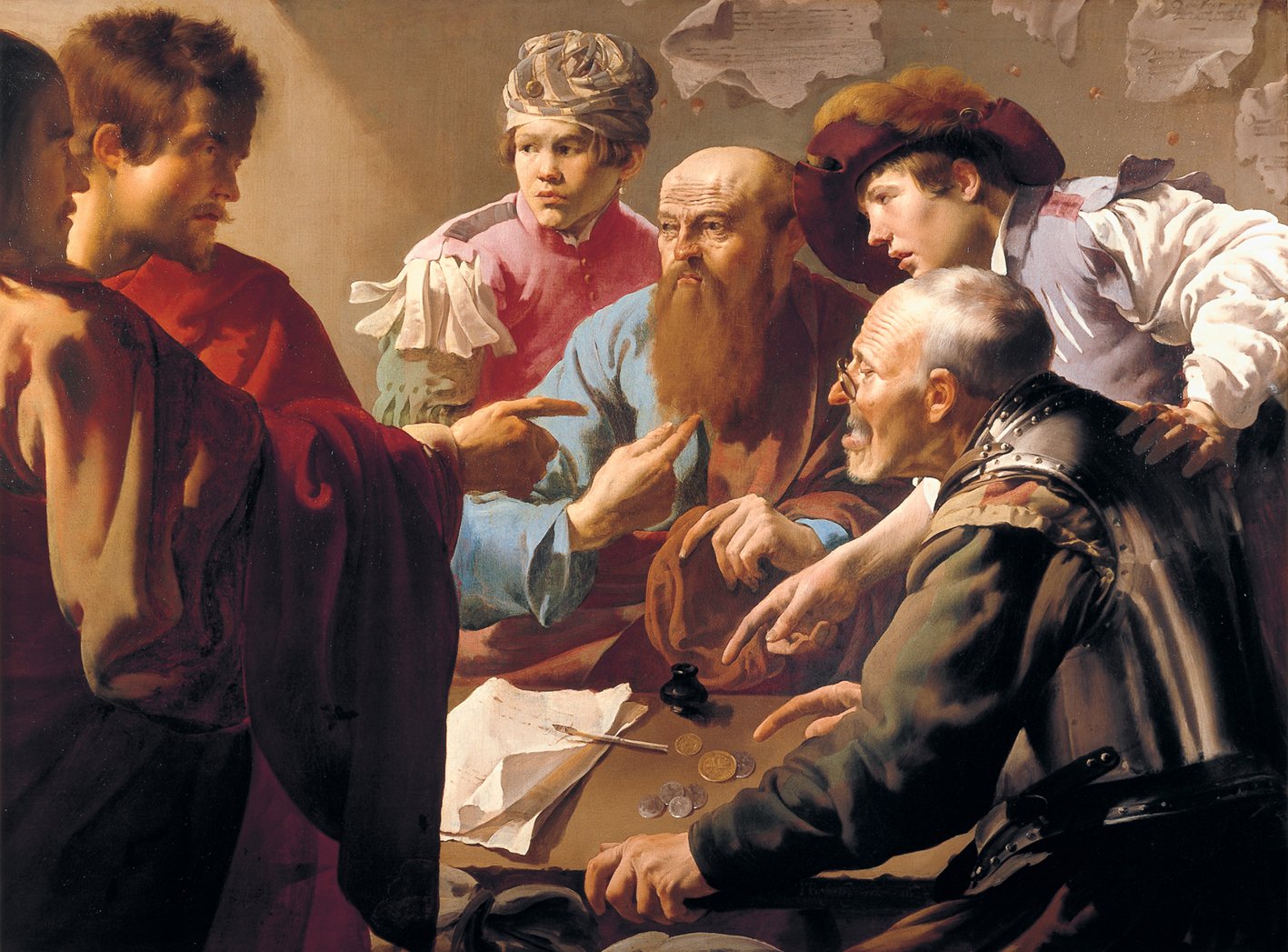In-your-face with the Holy Face! Bearing witness to the Faith through a lapel pin with an icon of Christ!
New Masters Degree: The Theology of the Body and the New Evangelization
Master of Sacred Arts at Pontifex University With a Concentration in the Theology of the Body Taught by Christopher West
Master of Sacred Arts at Pontifex University. Sign up today.
Wearing Your Heart on Your Lapel - A Novel Way to Bear Witness to Christ
I recently did a FB photopost on my icon lapel pin, and was surprised by the positive reaction, so I decided to write a little bit more about it!
In the West, we live in a time of steadily increasing hostility towards Christianity. Famously, the late and much missed Cardinal George of the Archdiocese of Chicago, who died of cancer in 2015, summed up the situation with the following statement made several years before his death:
I expect to die in my bed, my successor will die in prison and his successor will die a martyr in the public square.
This statement caught attention at the time, but it is not quite as pessimistic a statement as some have suggested. Clearly, there is an assumption here that his successors would be as orthodox in their faith as he was in his, and so merit attack from secular forces. Some might say that in itself was optimistic to the point of foolishness! But also, he went on to say in the same statement, that after the death of the martyr bishop:
His [the martyr's] successor will pick up the shards of a ruined society and slowly help rebuild civilization, as the church has done so often in human history.
In other words, we should not lose heart, for the Church will prevail regardless of the malice of men or the devil.
I thought about this recently when I heard a homily about the need to bear witness to the Faith today. The pastor made the point that while we are not at the point yet of being persecuted for our faith in this country, it might happen in the future and it is more likely to happen if we do not stand up for the Faith now. Countering prejudice at an early stage, he suggested, can help to stop it growing into open hatred and persecution in the future. He reminded us of how blessed we are in this country, still, compared with many who live in real fear for their lives for practising their faith, especially those in some predominantly Islamic countries.
I pray that if required, I might have the courage of the martyrs through the centuries who stood up to oppression whether it be from ISIS or the Emporer Diocletian.
In the meantime, the question is what can I do here and now to play my part? How do I bear witness in such as way that people know that I am Catholic and is likely to create a positive enough impression to draw people to the Faith?
The first thing, I think, is to acknowledge my need for God's grace to be able even to begin to live up to Christian ideals.
Second is let people know that I am a Christian. I live in the San Francisco Bay area and I often hear derogatory remarks about Christians and Christianity. Wherever possible I try to respond by casually and cheerily remarking that I am Christian. Usually, that has the simple effect of halting the conversation because no longer is 'the Christian' an abstraction in their imaginations, he is a real person. And I find that even here, most people shy away from offending flesh-and-blood people standing in front of them.
In his sermon, our pastor (at St Elias Melkite Catholic Church) suggested one simple way of discreetly but visibly making such a statement would be to wear a cross. He said that it would arouse curiosity and people would ask what it was. It would also, he suggested, give us the motivation to be better Christians because we are so clearly identifying ourselves with the Faith.
I have bought one and wear it, but I'll admit it sits under my shirt, only sometimes visible when I have an open-necked shirt. A necklace or medallion is not something that I would ordinarily wear and I don't feel absolutely comfortable with it. I decided to do something different that felt more natural to me. I found a company online that makes personalized lapel pins and so asked them to create some for me based on the Holy Face. I sent them a jpeg of the following icon:
When the batch came (I had to order 100) they looked like this:
Already, people have asked about it, and one even asked where I go to church, so I gave her a St Elias Melkite Catholic Church business card (which the pastor had printed up and encouraged us to have in our wallets, just in case!). I also see many people looking at it when I wear it although most do not say anything. Nevertheless, I am pleased about this because I feel that I have made a statement without saying anything in a way that I feel comfortable with.
I might be wrong, but I don't feel I am the sort whose natural gifts extend to being able to attract people to the Faith by standing on a soapbox and preaching on a street corner to passers-by; or by wearing a sandwich board that says: 'The End is Nigh' - as a man used to do for years in Liverpool city center when I was growing up in the 1960s and 70s.
Perhaps I am less courageous than this man. But a lapel pin is my way of being in-your-face with the Holy Face, while not looking as though that's what I'm trying to do. It was easy enough to do - you could easily create your own if you have a jpeg file of an image you like.
I am curious to hear from readers. Do you have any ways that tell people you are Christian without putting people off? I'd love to hear about what you do and the reactions you get. This is probably something that would appeal more to men than women, so what might women do alternatively?
Meanwhile, I am still waiting for someone to come up and incense my jacket...perhaps one day, you never know.
Our Lady of the Mount, Anjara, Jordan - a church and a story that reveals more of charism IVE
A mission parish of Argentinian order, Institute of the Incarnate Word (IVE), it commissioned four large new panel icons of the Mysteries of the Rosary; and is the place where in 2010, a statue of Our Lady wept tears of blood.
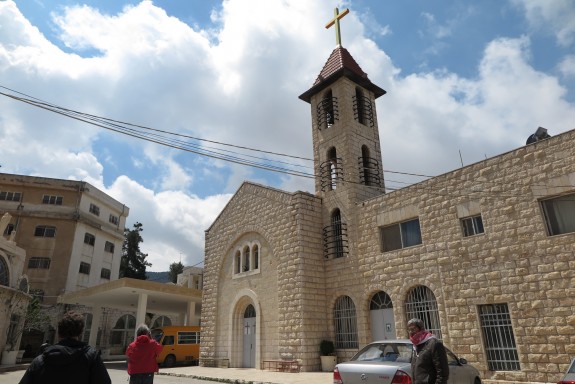
It is funny how one story leads to another, or perhaps I should say two others. I posted a recent article about my visit to the seminary of the Argentinian order Institute of the Incarnate Word (IVE) in Washington DC. First, I was contacted by English icon painter, Ian Knowles, who told me that this is the order that had commissioned him to paint icons of the Mysteries of the Rosary for a church run by them in Jordan. It is the Shrine of Our Lady of the Mount.
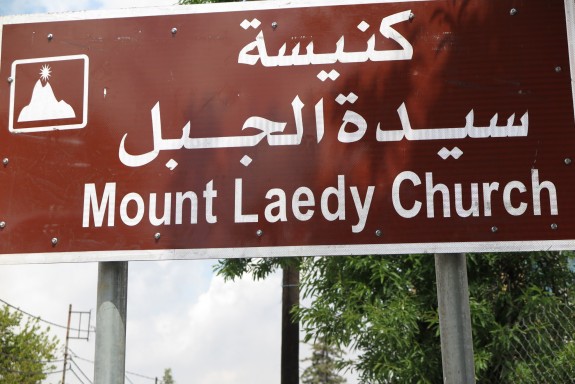
This was further evidence that the order is committed to the creation of beauty to evangelize the culture, as the description of their charism says, see here, item 5. I wanted to know more about the church and started to dig around. then I found out that it is also that it is the site of a miracle validated by the Latin Patriarch of Jerusalem, in which a statue of Our Lady wept tears of blood in 2010. The statue is old, perhaps 150-200 years old, and was purchased by the church shortly before the miracle occurred. In 2014, fellow Argentinian, Pope Francis visited the site of the Baptism of Our Lord in the Jordan and the occasion was marked by a gift from IVE of an image of Our Lady of Anjara.
Culture, beauty, prayer and devotion to Our Lady, all aspects of the charism of the order and somehow all of this is entwined in a dynamic mix for the mission of the Church in this one shrine in the Middle East.
For the icons, there are some photos below at the bottom of the blog post. Immediately below is artist Ian with one of the panels in progress (who incidentally I met several years ago when we both attended a class taught by Aidan Hart!) .
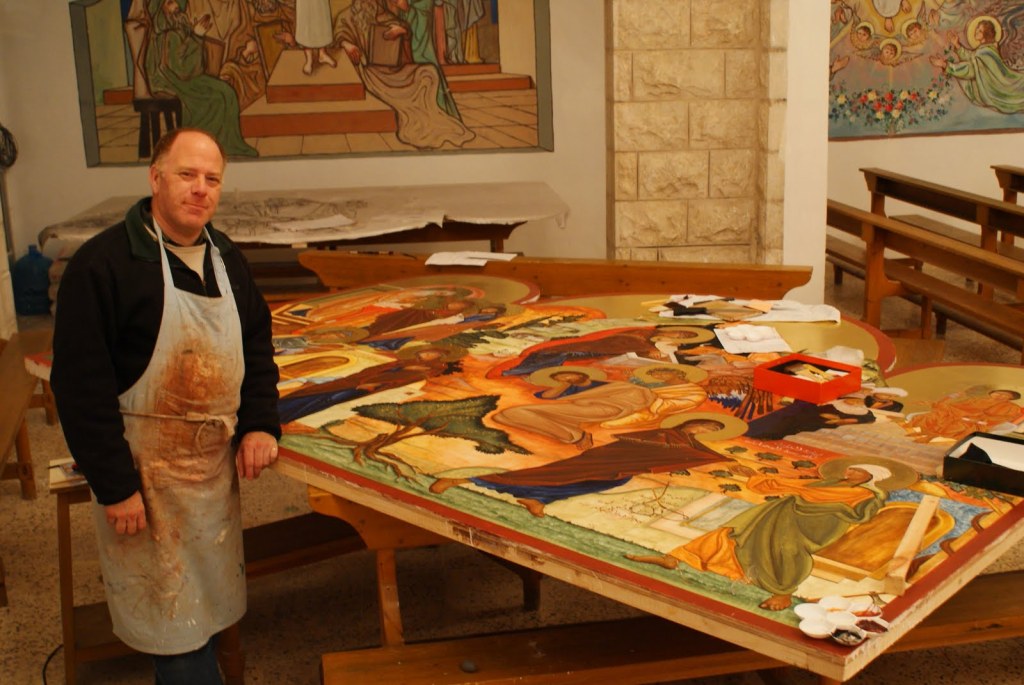
I am so heartened to hear of IVE wanting to encourage 'eyes-open prayer' through the commission of these icons. It shows, in my opinion, a true understanding of the New Evangelization as, regardless of the miracle, the simple beauty of each in the church, will encourage a deeper prayer that engages the whole person. This will facilitate a supernatural transformation of the person in Christ and lead, in turn, to the transformation of the culture as each person contributes to it, gracefully and beautifully by simply going about their daily business.
The same can be said of the statue. For all the headlines in connection with the miracle (which I very happy to accept occurred), it is the supernatural transformation of mankind in Christ - partaking of the divine nature - that is the truly astounding fact of the Christian faith; and this is an extraordinary privilege that is open to every single human person and leads to a life of such joy. Sometimes it needs the exceptional, headlining events such as miracles, to inspire the prayer that will engender what I think are the greater, yet so often neglected and misunderstood truths of the Faith.
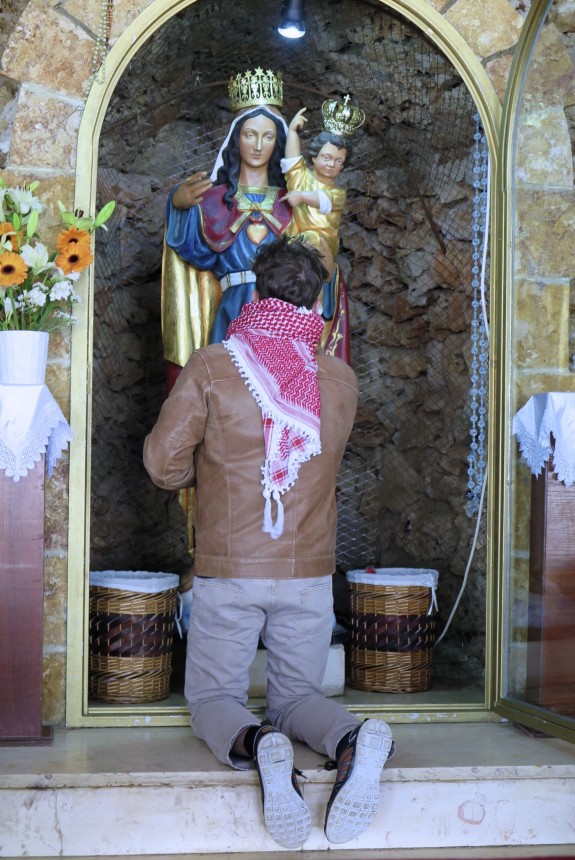
The account of the miracle is on the National Catholic Register, here. The account of the Pope's visit is on the IVE site, here. The order is devoted to Our Lady with a special devotion to the Immaculate Conception and Our Lady of Lujan, a South American holy image. What struck me in the account is how Argentinian priest of the order Fr Nammat says quite matter-of-factly that he doesn't know why the miracle should have occurred, except to remark that the 'Arab spring', which began the persecution of so many Christians (and Muslims) in the region began shortly afterwards, and perhaps there is a connection.
Below: Ian's Sorrowful Mysteries, with detail below that.
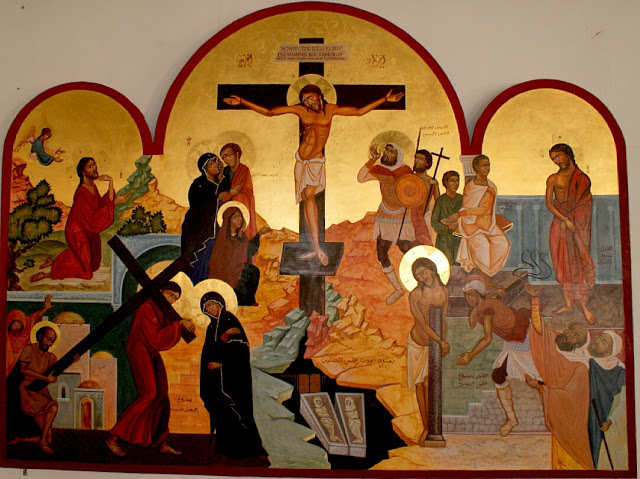
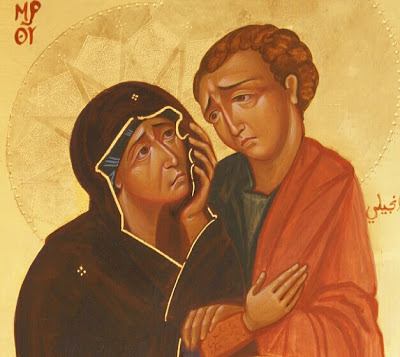
..and the Joyful Mysteries:
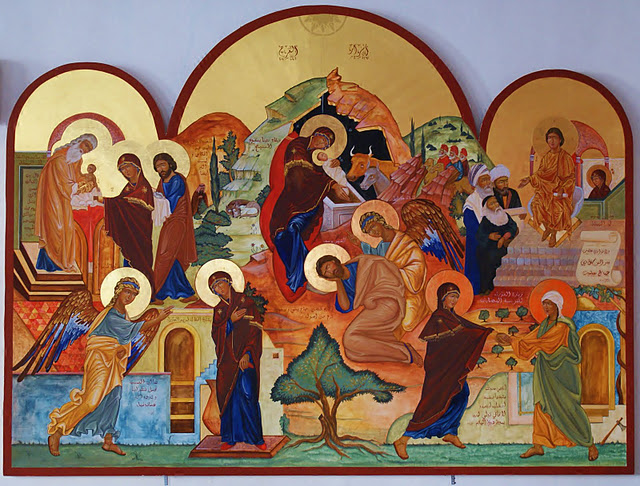
The New Evangelization and the Domestic Church - Pope Benedict XVI on the connection between the two
 Why the beauty of the prayer corner in the family home is crucial to the New Evangelization
Why the beauty of the prayer corner in the family home is crucial to the New Evangelization
The New Evangelization has become a buzzword of the age. Used by Pope St John Paul II it refers to the need to reach the faithless in the West whose parents and grandparents were Christian. But how do we reach these people who have no faith, but think they already know enough about Christianity to be hostile to it.?
In a short and clear paper written in 2000 Benedict XVI outlined what he believes is the answer to this question. If people are to convert they must believe that the Church has the answer to the fundamental question: 'Which is the path to happiness?' We do not tell people the answer to this question, he says, so much as show them. By the example of our own happy lives and loving interactions we show Christ to others. And the only way we can do this is to strive to be walking icons of Christ supernaturally transformed so that we participate in the 'light' of the Transfiguration.
There were two aspects of the Christian message that Pope Benedict felt would resonate today particularly when communicated in this way. First is that we demonstrate Christian joy that transcends human suffering so that in our own small way (or sometimes not so small) we bear suffering joyfully and with dignity as the martyrs did.
Second is that we should communicate the fact of life after death and a just and merciful judgment by Christ. When we have joyful hope for a future that reaches beyond death, fear is dispelled and we are given a purpose in this present life (anticipating themes discussed later in Spe Salvi in much greater depth). Again this is more powerfully transmitted in the way we are than by us telling people directly that we are joyful and free of fear.
How can we possibly live up to this ideal? The answer is that left to our own devices we can't, but with God's grace we can. The foundation of such a transformation says Benedict, is prayer.
Benedict describes prayer life that is a balance of three different sorts of prayer all ordered to the Eucharist. These are, first, the Sacred Liturgy - the Mass and the Liturgy of the Hours; second, 'para-liturgical' prayers which are devotional prayers said in common such as the rosary; and third personal prayer which is said alone and in private.
![]() Most of us do not know how to pray well without being taught. Even the apostles asked Christ to teach them how to pray and Benedict tells us that we need 'schools of prayer' where we may learn to pray this transforming prayer.
Most of us do not know how to pray well without being taught. Even the apostles asked Christ to teach them how to pray and Benedict tells us that we need 'schools of prayer' where we may learn to pray this transforming prayer.
The most powerful and ideal school of prayer is the domestic church - the family home - where children learn by seeing the example of their parents (and I would say, especially fathers) praying to God, visibly and audibly to the image corner. Benedict tells us that the domestic church is an essential aspect of the new evangelization:
'The new evangelization depends largely on the Domestic Church. The Christian Family to the extent it succeeds in living love as communion and service as a reciprocal gift open to all, as a journey of permanent conversion supported by the grace of God, reflects the splendor of Christ in the world and the beauty of the divine Trinity.'
So, he seems to be saying, if we did not learn to pray in our own home (perhaps because you are a convert like me), we have a responsibility to learn and then to pray at home so that we each create our own domestic churches.
Outside the family, a spiritual director is the best way to learn. These are hard to come by and so the next best thing is to look at books on prayer, Thomas Dubay's for example are good and of course one of the four sections of the Catechism is devoted to it.
The book, the Little Oratory, A Beginner's Guide to Praying in the Home was written by myself and Leila Lawler with this aim in mind. (The word 'oratory', incidentally, derived from the Latin orare - to pray - means literally 'house of prayer'.) In this we pass on the guidance we were given when we asked of others that question, 'teach us how to pray'. It describes how to order prayer in accordance with the hierarchy that Benedict describes so that it lightens the load of daily living rather becoming a burden. It addresses directly how to arrange the images for the icon corner in the home and how to pray to visual imagery.
The traditional layout for the core imagery of the icon corner is as follows: in the center should be the suffering Christ, that is Christ on the cross; to the left should be an image of Our Lady; and to the right should be an image of the glorified Christ (perhaps a Veronica cloth or Christ Enthroned with angels).
![]() It seems that nearly every aspect of the Faith is contained in some way in just these images and there simply isn't room to talk about it all here. However, it is interesting to note that they speak directly to the concerns that Benedict brought out in regard to the new evangelization: Christ on the cross is the most poignant symbol of consolation in our suffering; and all images of Christ glorified communicate to us the glory of heaven and what is in store for us through deification. This is the transformation by which we participate in the divine nature through Christ. It happens by degrees in this life through participation in the sacramental life.
It seems that nearly every aspect of the Faith is contained in some way in just these images and there simply isn't room to talk about it all here. However, it is interesting to note that they speak directly to the concerns that Benedict brought out in regard to the new evangelization: Christ on the cross is the most poignant symbol of consolation in our suffering; and all images of Christ glorified communicate to us the glory of heaven and what is in store for us through deification. This is the transformation by which we participate in the divine nature through Christ. It happens by degrees in this life through participation in the sacramental life.
Iconographic images of the face of Christ are always painted with an expression of compassion tinged with a slight sternness. This enigmatic combination tells us that Christ is a judge (hence the sternness), but that he is a good and merciful judge.
Finally, the role of Mary is crucial in the new evangelization, I believe. All that the Mother of God does is directing us to her son. We see this portrayed directly in many images of Our Lady - she engages us with her eyes while gesturing towards her son.
How will the domestic church evangelize the un-churched? At first sight it is not clear - it is possible that the images of the domestic church might communicate these truths to the faithless directly, who are invited into our homes, for example, but it is unlikely. That is not the point. The idea is that they are placed in the homes of the faithful for the effect it has on us. The beauty of sacred art communicates something that words alone cannot. When we pray with holy images, especially liturgical prayer as in the Divine Office, what we see impresses itself on our souls and we are raised up to the ideals they portray . Despite ourselves in many cases, we are transformed, partaking in the divine nature so that we may show Christ to others. As we leave our homes and go about our daily business, engaging with our fellows in a secular society, people see in us something greater, the divine person. It is Christ who affects those people, through us. It is a lay 'in persona Christi'. In so doing we emulate also, in our own diminished way, the life of Our Lady showed her son to us and prays for us to Him constantly.
I painted the images below as examples that would be appropriate for an icon corner in a Domestic Church. In addition to the three core images - the face of the glorified Christ, Christ on the cross and Our Lady of Merrimack. The first is in a traditional iconographic style and the other two are in a Western gothic style.
In addition is the image of the Knight of the New Evangelization which I have painted as a symbol of the mission of the Church today. He portrays the need for chivalry and virtue in today's culture which is hostile to Christianity. The battle in the West is spiritual but nevertheless requires courage. The image is based on one from the 13th century Westminster psalter painted by Matthew Parris
Don't forget the Way of Beauty online courses www.Pontifex.University (go to the Catalog) for college credit, for continuing ed. units, or for audit. A formation through an encounter with a cultural heritage - for artists, architects, priests and seminarians, and all interested in contributing to the 'new epiphany of beauty'.
New book for prayer in the home that will 'transform the family and society'
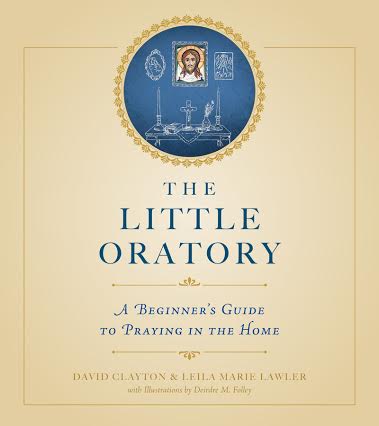 My book, co-authored with Leila Lawler, is now out and can be ordered from the publisher Sophia Institute Press. It is called The Little Oratory - A Beginner's Guide to Praying in the Home. The claim in the title about the impact it will have, incidentally, is not my own but is taken from a review by Scott Hahn, which I give in full below (although I do hope his assessment is correct!)
It is a practical program in mystagogy - the teaching of the mysteries of the Faith - that promotes a cultural renewal through a liturgical piety in the family and parish. It explains how to build a prayer corner - a 'little oratory' - as the centre of family prayer and has eight color detachable icons in standard sizes for framing, to get you started. The paintings you see in this article are from the book.
My book, co-authored with Leila Lawler, is now out and can be ordered from the publisher Sophia Institute Press. It is called The Little Oratory - A Beginner's Guide to Praying in the Home. The claim in the title about the impact it will have, incidentally, is not my own but is taken from a review by Scott Hahn, which I give in full below (although I do hope his assessment is correct!)
It is a practical program in mystagogy - the teaching of the mysteries of the Faith - that promotes a cultural renewal through a liturgical piety in the family and parish. It explains how to build a prayer corner - a 'little oratory' - as the centre of family prayer and has eight color detachable icons in standard sizes for framing, to get you started. The paintings you see in this article are from the book.
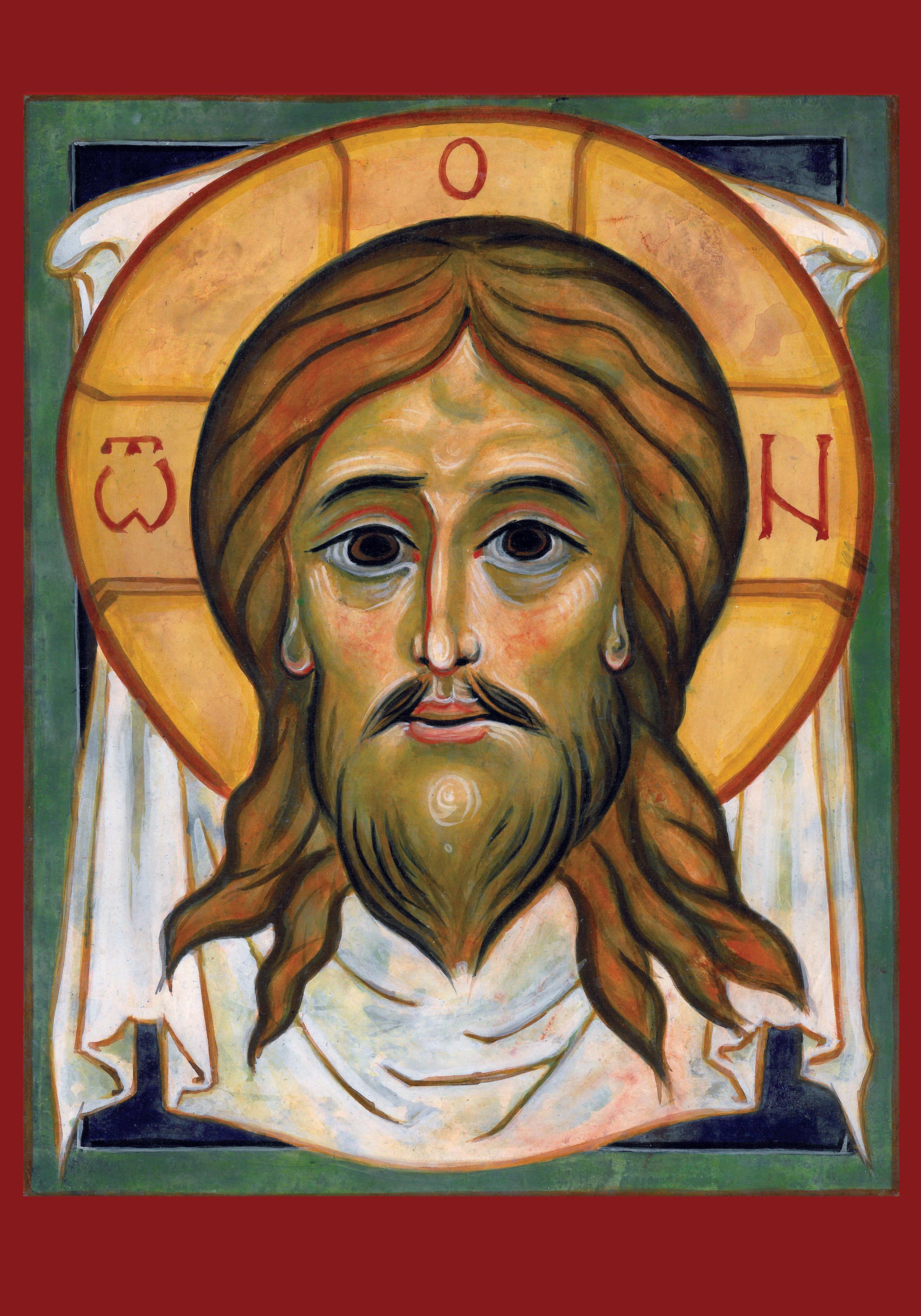 It addresses the crisis of fatherhood by explaining crucial role of fathers in family prayer. By encouraging fathers (as well as mothers!) to be an example in prayer it will help to encourage vocations for it will teach boys that prayer and worship are masculine activities as well as feminine.
It addresses the crisis of fatherhood by explaining crucial role of fathers in family prayer. By encouraging fathers (as well as mothers!) to be an example in prayer it will help to encourage vocations for it will teach boys that prayer and worship are masculine activities as well as feminine.
As such it is a family centered, practical manual for the New Evangelisation that could be promoted by parishes or cultural centres. It explains how family prayer can be the basis for building up communities beyond the family in parishes, for example, and even the workplace.
Here is what Scott Hahn wrote about it:
'This is one of the most beautiful books I've ever seen. How I wish I'd had it when I first became a Catholic, not just for myself, as a husband and father, but for my family, too. It's a commonplace of Christian tradition to call the home a sanctuary or "domestic church," but before a home can be a church, it must become an oratory -- a place of prayer. The authors of this book know that there are many obstacles, and they show us how to overcome them. This book is inspiring yet practical, realistic yet revolutionary. If one book has the potential to transform the Catholic family (and society), this is it.'
![]() It adapts for the family the traditional spirituality of artists that forms the person in humility so that they are open to inspiration and it engenders creativity. In addition it describes the practical aspects of an education in beauty based upon the traditional education of artists and how this can be applied at any level. It could be introduced, for example, into homeschooling groups, at a college level (I have been doing this in my Way of Beauty class) or even the basis of an MFA. The Sophia Institute Press site here [] includes downloadable high resolution prints of the icons in the book and numerous line drawings for coloring and for copying to help teach children how to draw (scroll down to the bottom of the page and you'll find the link). This really is useful at all levels - I teach adults in my classes using these same images.
It adapts for the family the traditional spirituality of artists that forms the person in humility so that they are open to inspiration and it engenders creativity. In addition it describes the practical aspects of an education in beauty based upon the traditional education of artists and how this can be applied at any level. It could be introduced, for example, into homeschooling groups, at a college level (I have been doing this in my Way of Beauty class) or even the basis of an MFA. The Sophia Institute Press site here [] includes downloadable high resolution prints of the icons in the book and numerous line drawings for coloring and for copying to help teach children how to draw (scroll down to the bottom of the page and you'll find the link). This really is useful at all levels - I teach adults in my classes using these same images.
 In addition it explains:
• Why the Liturgy of the Hours is important and how it can make your family holy
• How to sing your prayers even if you think you're tone deaf or timid
• How to pray the Rosary with children—and keep the rowdiest of them calm and reverent
• The active role children can play in the prayer life of the family and how to raise the cultural sensibilities of your children so they are more sensitive to divine beauty.
• What to do when only one parent takes the spiritual life seriously
• How to overcome the feeling that you’re too busy to pray
• Practical ways to extend the liturgical life into your workplace
In addition it explains:
• Why the Liturgy of the Hours is important and how it can make your family holy
• How to sing your prayers even if you think you're tone deaf or timid
• How to pray the Rosary with children—and keep the rowdiest of them calm and reverent
• The active role children can play in the prayer life of the family and how to raise the cultural sensibilities of your children so they are more sensitive to divine beauty.
• What to do when only one parent takes the spiritual life seriously
• How to overcome the feeling that you’re too busy to pray
• Practical ways to extend the liturgical life into your workplace
It has been well received so far and is endorsed also, by figures such as Joseph Pearce, Christopher West and Tom Howard. It is with the words of well-known Catholic writer Tom Howard that I finish: 'It is difficult indeed to refrain from superlatives when speaking of this book. It's all here. One would like to shout from the housetops, "Drop everything and start using this!" Here we find virtually all that could possibly be wanted for true Catholic household prayer. The liturgy, the Church year, the Hours, music, chant, icons, the Rosary, lots of "how to" helps, even tips on Catholic household décor. And the great thing is that it is all presented in clear, strong, sane, modest, unembellished prose. The helpful commentaries turn out to be luminous meditations actually. The book is a rare treasure.'
Buy the Little Oratory - A Beginner's Guide to Prayer in the Home from the Sophia Institute Press site, here.
Bill Nelson and Be Bop Deluxe
I have not met a mother yet who does not think that her baby is the most beautiful baby there is. When I first heard a mother saying it, I thought perhaps there was some element of irony. All babies are beautiful, I thought, but you don't really believe that yours is the most beautiful do you? I once aired these doubts. I laughed and said to the mother that every mother I had met thought that. Yes, she replied in absolute seriousness, without even a trace of irony: 'Except that my baby really is the most beautiful.' This is how the eyes of love see the beloved. I imagine this might give us insight into how God sees every single one of us. The mother is not blinded by love. Just the opposite - the scales have fallen off her eyes so that she sees the true value of that one small person. It may exist, but I have never seen the same level of devotion from fathers. In men this natural instinct seems to be misdirected and applied to more superficial things. I have seen devotion to fourth rank professional soccer team, Tranmere Rovers (who at this time in the early Eighties were averaging gates of 800 people) so great that when I asked him to explain why his beloved team was languishing at the foot of the table he replied in all seriousness, again no irony whatsoever, that it was all down to a complete season of 'bad refereeing'...nevertheless he was convinced that this wouldn't contintue, that the future held hope and tipped them for promotion the following season. This, I suggest, is blind devotion.
On a similar level of superficiality, guys have a blindness to the awfulness of the rock or pop music they grew up with. There is nothing worse than listening to somebody else's greatest hits collection on their iPod; and nothing better than listening to your own. Especially when its a 50 year old man and everything dates from the strictly delineated time period of 1973-1988, after which time all pop music 'went downhill' so demonstrating that the youth of today listen to tuneless, raucous, inane rubbish barely meriting the categorization of music (so different to what we used to listen to). After 1988 this typical man started to branch out into jazz and classical and maybe now listens to chant and polyphony. But he still won't let go of all of the rock music he grew up with, and is convinced that it has genuine artistic merit.
I might say that this hypothetical example described above applied to me...except that the music I have downloaded onto my iShuffle really is the best from a golden age of popular culture when there was genuine musicianship and that everybody should be able to appreciate it!
And to prove it here is a video of the singer/songwriter from one of my favourite groups from the late 1970s, Bill Nelson whose group was Be Bop Deluxe. When I was surfing around the net one day, I was amazed to come across this old interview with him in which he does describe the process of inspiration as something that comes from God. This is all I need, I thought, reference to God will justify its inclusion in this blog....
Joking aside, regardless of what you think of my taste for out-of-date pop music (which is probably slightly worse than I think it is), I would love to see a new popular music appear as part of the New Evangelisation. It is an assumption of many people today that what sells appeals to the lowest common denominator and can never raise people's souls to God. I do not agree. However, the answer is not, repeat not, Christian rock as we hear it today (which is just a pale version of the forms) which no self-respecting rock fan would every really listen to. Rather, it is up to Christians to find music that is entertaining and accessible, that is powerful and beautiful. If what is good appeals to something that is ordered in us, it will always have a greater appeal than that which appeals to what is disordered in us. This will involve consideration of harmonic forms as well as the words and might well include also modern developments in rhythm and electrical manipulation of sound. Just like any aspect of the culture, provided it is employed discerningly it can be transformed into something good.
I do not know what such music will sound like. While I think it is unlikely that it could convert, it can begin to open the door to something better. The groups that I gravitated to when I was listening, I found out afterwards, were often those who avoided the rock'n'roll blues scales and harmonies, and used more conventional harmony and counterpoint. It may be a surprise to some that such groups did exist and I know of one or two trying to do this now. George Sarah in California is one. This stimulated a desire for something more that took me to classical music and ultimately liturgical.
So for any whose interest persists, here is some music by the 'fastest guitarist in Wakefield' Bill Nelson. Some from their heyday in the Seventies and a recent recording of him playing the 1975 song Maid in Heaven, now 63 and still very sharp and clear in voice and instrumental technique. The first one is the interview of him after this in the 1980s when he became more art-house in his approach. In regard to this it is interesting that even in guitar playing he describes how important, just as in the training of painting, the imitation of great masters was in helping him to learn (in this case the Old Masters were his boyhood guitar heroes!)
St Barnabas, St Paul and St Thomas More on Cultivating Christian Joy, Even in Suffering: speaking to us through the Liturgy of Hours
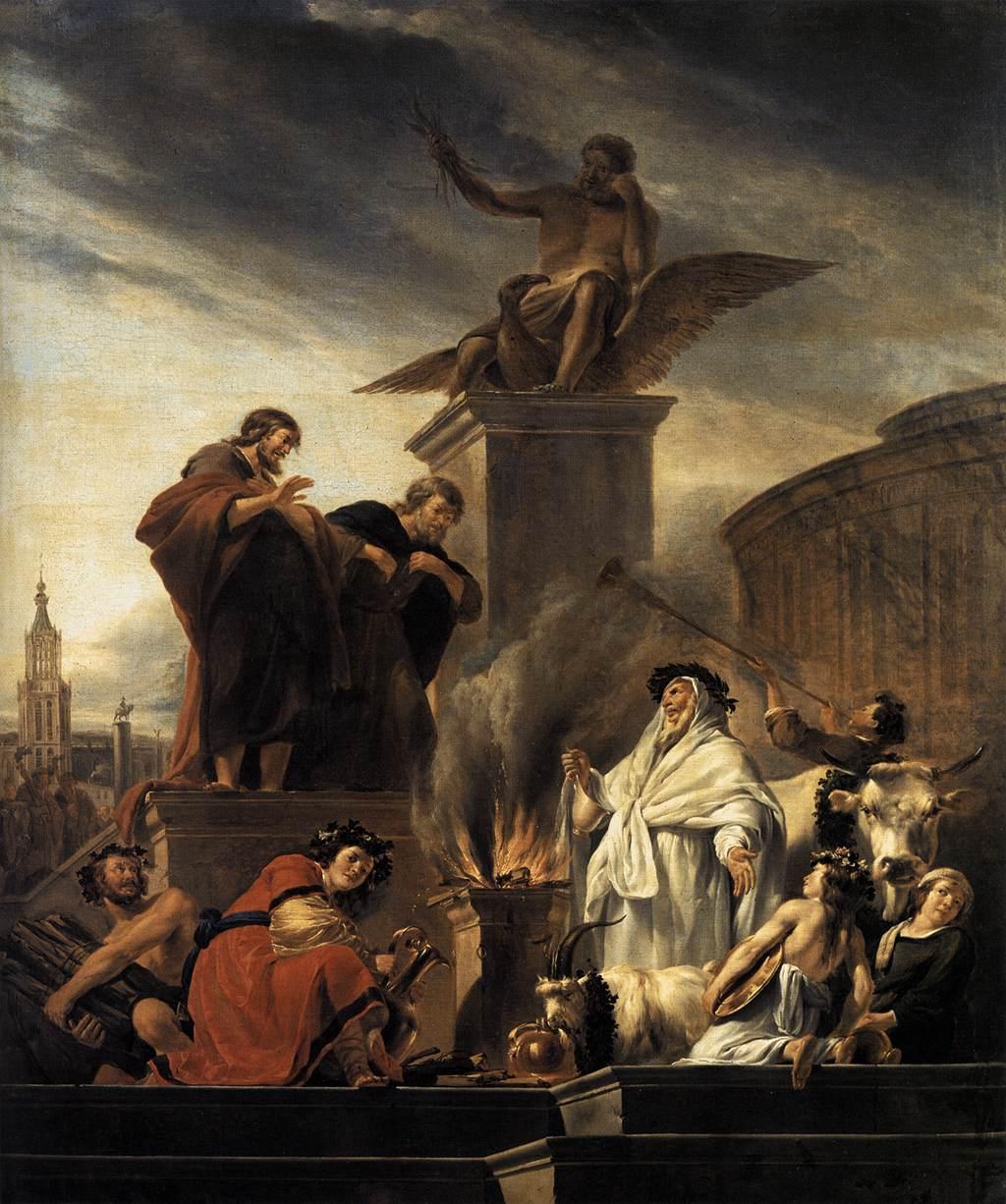 ‘Whatever experience comes your way, accept it as a blessing, in the certainty that nothing can happen without God’ Letter attributed to Barnabas, Ch 19
I am a convert. There are of course, many reasons that I became a Catholic, but an important one was the conviction that I would lead a happier life if I did. (I’m talking about this life, the here-and-now as much as the hereafter.)
‘Whatever experience comes your way, accept it as a blessing, in the certainty that nothing can happen without God’ Letter attributed to Barnabas, Ch 19
I am a convert. There are of course, many reasons that I became a Catholic, but an important one was the conviction that I would lead a happier life if I did. (I’m talking about this life, the here-and-now as much as the hereafter.)
One of the most influential figures in my conversion was a man called David who insisted that Christian joy comes as a result of the personal choices we make and is open to anyone. He taught me also how to cultivate Christian joy. David, incidentally, is the same person who gave me the vocational guidance that I have referred to before, here, and which rests so much on an assumption that God wants us to be happy. I was prepared to listen to him because he genuinely seemed a joyful person to me; and this was despite the fact that he had a heart condition that meant he could not walk without a stick and had to rest to catch his breath every 50 yards. The example of joy in adversity was powerful.
I have been reminded of David and his lessons of over 20 years ago now recently through readings from the liturgy of the hours. The things that he said to me about the joy of the Catholic life seem to me to be echoed in three readings I noticed this summer. This reinforces the for me just how powerful the liturgy is in educating and forming the person.
There are a number of aspects to cultivating joy of course, but one powerful contributor was a simple meditation called ‘counting my blessings’. Each day, he suggested, I should write down the good things that have happened that day – a ‘Gratitude List’ - and then as part of my daily prayers, thank God for these gifts. He was insistent that actually writing them down was important.
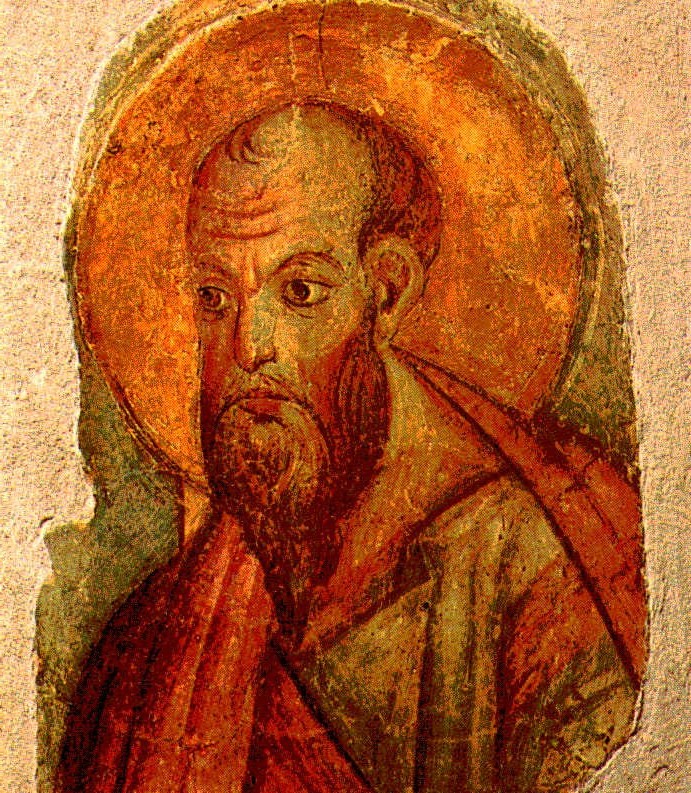 When I first met him I was miserable and not grateful for very much at all. He wrote out my first Gratitude List for me, which at this stage consisted of things I ought to be grateful for rather than things that I actually felt grateful for. I remember him starting with the basic necessities: he asked me first if I had eaten that day, then he wrote down ‘food’; then he looked at me and noted that I was clothed, and wrote ‘clothes’ on the list. ‘Do you have somewhere to sleep tonight?’ he asked me. When I answered yes he wrote to down, ‘Bed to sleep in’; and then he asked, is this outside or indoors? He wrote down ‘roof over my head’. Then he paused: ‘You have affirmed to me that each item on this list is true. So here you have written proof that this morning when you asked God to look after you today, he answered your prayer.’ He also told me that these things’ put me ahead’ of a significant proportion of the world’s population who didn’t know where their next meal was to come from. ‘Therefore,’ he said, ‘You really don’t have any good reason for complaining about your lot.’
When I first met him I was miserable and not grateful for very much at all. He wrote out my first Gratitude List for me, which at this stage consisted of things I ought to be grateful for rather than things that I actually felt grateful for. I remember him starting with the basic necessities: he asked me first if I had eaten that day, then he wrote down ‘food’; then he looked at me and noted that I was clothed, and wrote ‘clothes’ on the list. ‘Do you have somewhere to sleep tonight?’ he asked me. When I answered yes he wrote to down, ‘Bed to sleep in’; and then he asked, is this outside or indoors? He wrote down ‘roof over my head’. Then he paused: ‘You have affirmed to me that each item on this list is true. So here you have written proof that this morning when you asked God to look after you today, he answered your prayer.’ He also told me that these things’ put me ahead’ of a significant proportion of the world’s population who didn’t know where their next meal was to come from. ‘Therefore,’ he said, ‘You really don’t have any good reason for complaining about your lot.’
This was over 20 years ago and since then, pretty much daily, I have been writing a gratitude list. To this list of necessities, I always add half a dozen or so ‘luxuries’: the things that I have received that a more than what need. So any through this I thank God as well for any other positives in the day, major or minor. Pretty soon, perhaps after about a month or so, I noticed that I genuinely felt grateful for these things. But the benefits went further than that. The result for me has been to reinforce the faith in a loving God who is actively looking after me. There has never been a day when I haven’t been given all that I need.
This does seem to leave gaps though. It’s one thing to appreciate the good things, but another to accept the bad things and still be happy. I have had to deal with many of the setbacks and disappointments that one would expect in an ordinary life. They way I deal with these is to remember something else that David told me. That if we assume that a loving God is working in my life and wants me to be happy, then I should remember that all that happens is either willed by God directly, or if it is bad, is permitted by God for good reason. (God, who is all goodness cannot be the author of something that is bad.) This means that if I could see the bigger picture then I would be able to see what this greater good was but because I am not able to I can have faith that there is a greater good nevertheless. Perhaps it is a lesson learnt for the good of my soul, or it is directing me down a path that will reap greater rewards later. In order to help cultivate gratitude for these bad things, David used to put them on his gratitude list too and praise God for them, on the grounds that even these must be permitted by a God who had his best interests at heart. I have adopted his habit and have found this powerful in helping to intensify a faith in a loving God.
This last point was reinforced by two quotations in the Liturgy recently.
 From Office of Readings, Wednesday Week 18 of the Year, Letter attributed to Barnabus, Ch 19: ‘Whatever experience comes your way, accept it as a blessing, in the certainty that nothing can happen without God.’
From Office of Readings, Wednesday Week 18 of the Year, Letter attributed to Barnabus, Ch 19: ‘Whatever experience comes your way, accept it as a blessing, in the certainty that nothing can happen without God.’
From Lauds, Wed, Week II, Romans 8:35, 37: 'Nothing can come between us and the love of Christ, even if we are troubled or worried, or being persecuted, or lacking food or clothes, or being threatened or even attacked. These are the trials through which we triumph, by the power of him who loved us.'
Despite the success of this tool in my own life, it still doesn’t go far enough, I think. In many ways I have led a privileged life and haven’t had to face extreme suffering. This little technique might be good for the everyday ups and downs of everyday life, but does this idea apply to those who suffer torture, or who went through the Nazi concentration camps. This is where the study of the lives of the saints paid dividends for me. I studied the writing of saints who had been through such things and was struck by the joy they talk about even in such adversity. It seems that God’s grace really can overcome anything. I should state at the same time, I am very far from ready to volunteer for such suffering. However, the more I read passages such as the one that follows, the more it reinforces the idea that whatever the situation there is sufficient grace, if I cooperate, for me to overcome it.
 From Office of Readings, June 22nd, a letter written by St Thomas More to his daughter Margaret from prison: 'Although I know well, Margaret, that because of my past wickedness I deserve to be abandoned by God, I cannot but trust in his merciful goodness. His grace has strengthened me until now and made me content to lose goods, land, and life as well, rather than to swear against my conscience. God’s grace has given the king a gracious frame of mind toward me, so that as yet he has taken from me nothing but my liberty. In doing this His Majesty has done me such great good with respect to spiritual profit that I trust that among all the great benefits he has heaped so abundantly upon me I count my imprisonment the very greatest. I cannot, therefore, mistrust the grace of God. Either he shall keep the king in that gracious frame of mind to continue to do me no harm, or else, if it be his pleasure that for my other sins I suffer in this case as I shall not deserve, then his grace shall give me the strength to bear it patiently, and perhaps even gladly.
From Office of Readings, June 22nd, a letter written by St Thomas More to his daughter Margaret from prison: 'Although I know well, Margaret, that because of my past wickedness I deserve to be abandoned by God, I cannot but trust in his merciful goodness. His grace has strengthened me until now and made me content to lose goods, land, and life as well, rather than to swear against my conscience. God’s grace has given the king a gracious frame of mind toward me, so that as yet he has taken from me nothing but my liberty. In doing this His Majesty has done me such great good with respect to spiritual profit that I trust that among all the great benefits he has heaped so abundantly upon me I count my imprisonment the very greatest. I cannot, therefore, mistrust the grace of God. Either he shall keep the king in that gracious frame of mind to continue to do me no harm, or else, if it be his pleasure that for my other sins I suffer in this case as I shall not deserve, then his grace shall give me the strength to bear it patiently, and perhaps even gladly.
By the merits of his bitter passion joined to mine and far surpassing in merit for me all that I can suffer myself, his bounteous goodness shall release me from the pains of purgatory and shall increase my reward in heaven besides.
I will not mistrust him, Meg, though I shall feel myself weakening and on the verge of being overcome with fear. I shall remember how Saint Peter at a blast of wind began to sink because of his lack of faith, and I shall do as he did: call upon Christ and pray to him for help. And then I trust he shall place his holy hand on me and in the stormy seas hold me up from drowning.
And if he permits me to play Saint Peter further and to fall to the ground and to swear and forswear, may God our Lord in his tender mercy keep me from this, and let me lose if it so happen, and never win thereby! Still, if this should happen, afterward I trust that in his goodness he will look on me with pity as he did upon Saint Peter, and make me stand up again and confess the truth of my conscience afresh and endure here the shame and harm of my own fault.
And finally, Margaret, I know this well: that without my fault he will not let me be lost. I shall, therefore, with good hope commit myself wholly to him. And if he permits me to perish for my faults, then I shall serve as praise for his justice. But in good faith, Meg, I trust that his tender pity shall keep my poor soul safe and make me commend his mercy.
And, therefore, my own good daughter, do not let your mind be troubled over anything that shall happen to me in this world. Nothing can come but what God wills. And I am very sure that whatever that be, however bad it may seem, it shall indeed be the best.'
Images: Nicolaes Berchem, St Paul and St Barnabas Preaching at Lystra, 17th century. St Paul, ancient wall painting; St Barnabus, Rembrandt, 17th century; St Thomas More, polychrome statue at St Thomas More parish, Pottsdown, Pennsylvania. Below: Hans Holbein' drawing of the More
The Way of Beauty and the New Evangelisation
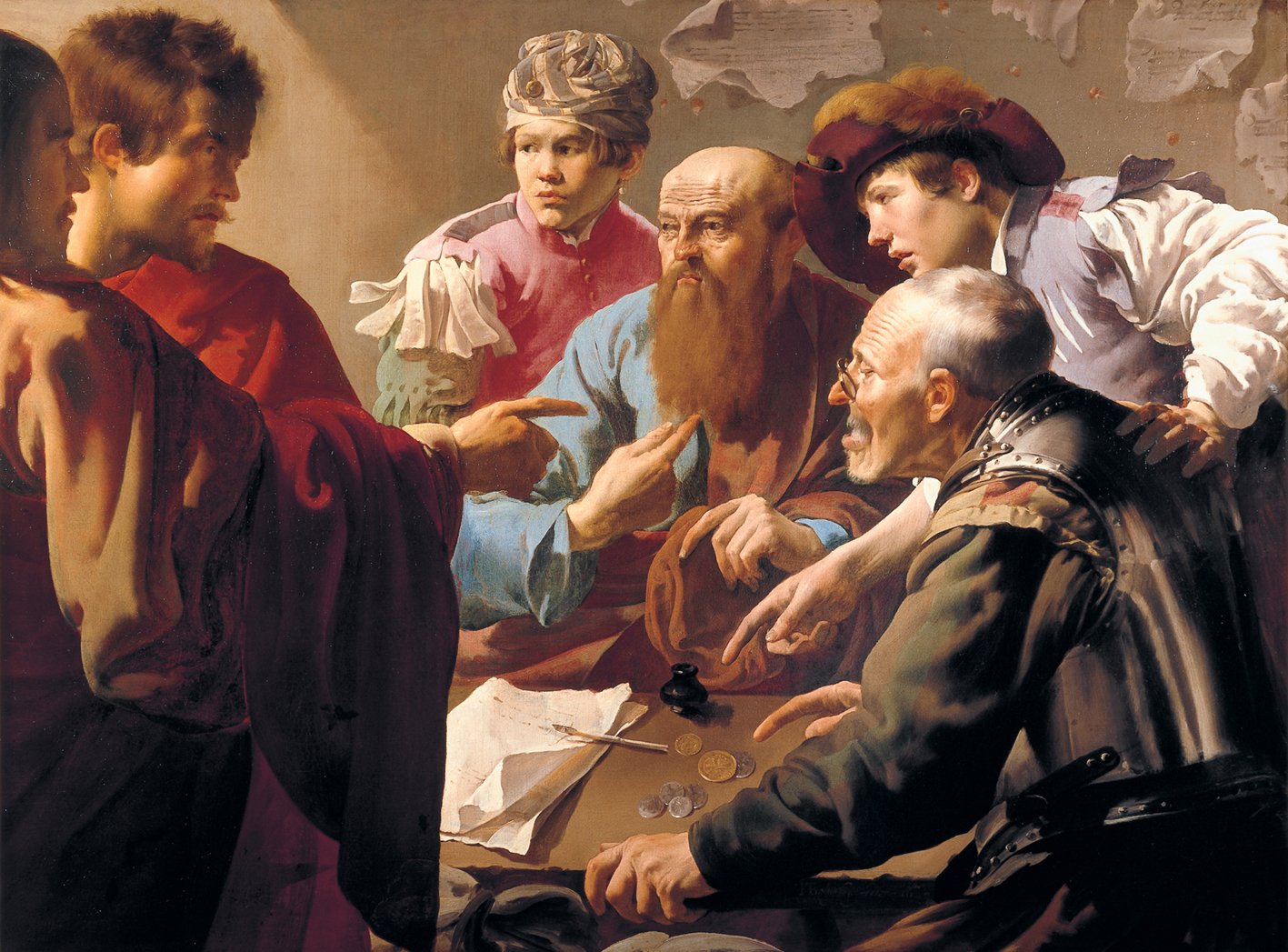 Why an education in beauty and the Liturgy of the Hours are important in the formation of lay people as part of the New Evangelisation. Thomas More College of Liberal Arts was treated to a lecture by a husband-and-wife team of theologians who both teach at St John's Seminary at Boston. David and Angela Franks run the newly established Masters of Theological Studies for the New Evangelization. Although based at the Seminary, this is aimed at lay formation and can be taken on a part-time basis. It is the first new programme of the Seminary's newly established, Theological Institute for the New Evangelisation (TINE).
David and Angela inspired our students (and myself!) with the vision that the Church has for the role of lay people in evangelising the modern world, charactererised by John Paul II as the New Evangelisation. All this is invaluable in itself, but what surprised and interested me particularly was their assertion that an education in beauty is an essential element in the formation of the individual who is going to be carry out their mission of taking the Word to the world. Furthermore, they highlighted the importance of the Liturgy of the Hours in this education.
Why an education in beauty and the Liturgy of the Hours are important in the formation of lay people as part of the New Evangelisation. Thomas More College of Liberal Arts was treated to a lecture by a husband-and-wife team of theologians who both teach at St John's Seminary at Boston. David and Angela Franks run the newly established Masters of Theological Studies for the New Evangelization. Although based at the Seminary, this is aimed at lay formation and can be taken on a part-time basis. It is the first new programme of the Seminary's newly established, Theological Institute for the New Evangelisation (TINE).
David and Angela inspired our students (and myself!) with the vision that the Church has for the role of lay people in evangelising the modern world, charactererised by John Paul II as the New Evangelisation. All this is invaluable in itself, but what surprised and interested me particularly was their assertion that an education in beauty is an essential element in the formation of the individual who is going to be carry out their mission of taking the Word to the world. Furthermore, they highlighted the importance of the Liturgy of the Hours in this education.
They described a process that is both active and reactive. The active role is one of living the life of faith, which is ultimately living the life of love that God intends for us. And we should do so, they said, without apologising for it!
There is a description in the Acts of the Apostles of the growth of the early Church in which people were attracted to the Christian life, we are told, 'because they loved each other'. When we lead a life of love then our lives will be beacons of light that will arouse curiosity in this secular society. Love is not so much a set of feelings but rather a set of actions motivated for the good of the other. That requires fortitude especially because it is precisely this that will cause us to stand out in the crowd and because, as David puts it, we live in an age when 'powerful forces are arrayed against true love'.
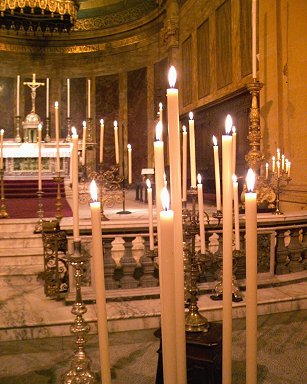 That light will be brightest when we are answering most completely the personal vocation that God has made to us (aside from following the commandments of the Church). The determination of this personal vocation is an important early step therefore. I was lucky in my own life in being given some inspired guidance in trying to discern what this might be. This has ended up in me doing what I am now at Thomas More College. I have described the process here. The programme at the St John's Seminary offers guidance also in this first step.
That light will be brightest when we are answering most completely the personal vocation that God has made to us (aside from following the commandments of the Church). The determination of this personal vocation is an important early step therefore. I was lucky in my own life in being given some inspired guidance in trying to discern what this might be. This has ended up in me doing what I am now at Thomas More College. I have described the process here. The programme at the St John's Seminary offers guidance also in this first step.
The second part is reactive. When people see a life of love it arouses curiosity and they ask questions. At this point we need to be able to answer them truthfully and prudently. Part of the programme at St John's is about equipping people with knowledge of the truth - we must know what the Church teaches, or at the very least, where to go to find out what the Church teaches.
But also, we must present this information in such a way that it continues to attract people. Force of logic will only take you so far. It is not just what you say, but how you say it. Prudence guides this. While knowing what to say and when can be trained in some ways directly, so much of this is about developing an intuitive sense of it. A key principle in operation here is beauty. When we do something attractively, we are doing it beautifully. This is why a training in beauty is so important, we were told. It develops that instantaneous intuitive sense of knowing what to do best.
After the talk there was a lively question and answer session and one student asked directly. What should we be aiming for in our spiritual lives in order to be able to achieve this? To my great delight, David answered without hesitation, that beyond the basic requirements of the sacramental life, he felt that the Liturgy of the Hours was a powerful and 'supremely effective' form of prayer.
David and Angela invite everyone who might be interested to take a look at the exciting opportunities for lay people offered by St John's Seminary. You can find out more by going to the www.sjs.edu and clicking on the 'TINE' logo.
For a growing series of articles about the Liturgy of the Hours as part of The Way of Beauty, see here.
Thomas More College of Liberal Arts offers a traditional education in beauty, incorporating the Liturgy of the Hours as one of the key components of the spiritual life of the college. The course, The Way of Beauty is part of its core curriculum with the intention of offering our students to best chance of coming out as ambassadors of the New Evangelisation.
In addition, our summer programme has short courses open to everyone to teach precisely this. Artists and musicians can learn it in conjunction with the skills of icon painting, academic drawing or Gregorian chant in our two-week programmes in July. Our weekend retreat in creativity and inspiration in August offers everyone else the chance to learn the traditional education in beauty - developed as part of the training of artists - but without having to learn the artistic skills. For more information about all of these courses see here.
Images Top and bottom: The Calling of St Matthew by Hendrick ter Brugghen, 1621; candles at the Birmingham Oratory, England; The Presentation of Jesus at the Temple (Candlemass) by Tintoretto, c1550
















